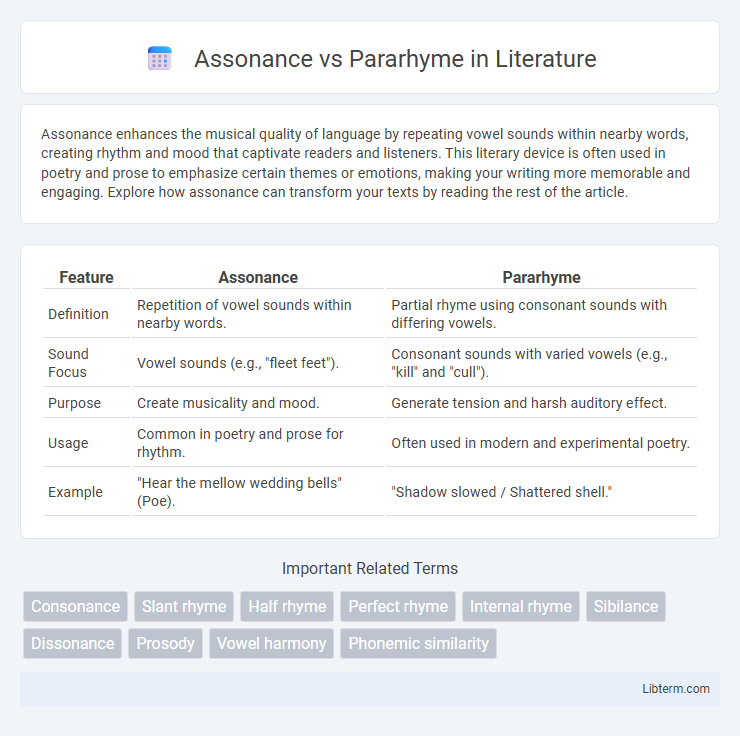Assonance enhances the musical quality of language by repeating vowel sounds within nearby words, creating rhythm and mood that captivate readers and listeners. This literary device is often used in poetry and prose to emphasize certain themes or emotions, making your writing more memorable and engaging. Explore how assonance can transform your texts by reading the rest of the article.
Table of Comparison
| Feature | Assonance | Pararhyme |
|---|---|---|
| Definition | Repetition of vowel sounds within nearby words. | Partial rhyme using consonant sounds with differing vowels. |
| Sound Focus | Vowel sounds (e.g., "fleet feet"). | Consonant sounds with varied vowels (e.g., "kill" and "cull"). |
| Purpose | Create musicality and mood. | Generate tension and harsh auditory effect. |
| Usage | Common in poetry and prose for rhythm. | Often used in modern and experimental poetry. |
| Example | "Hear the mellow wedding bells" (Poe). | "Shadow slowed / Shattered shell." |
Introduction to Sound Devices in Poetry
Assonance is the repetition of vowel sounds within nearby words, creating internal rhyming and enhancing musicality in poetry. Pararhyme involves consonant sounds matching while vowel sounds differ, producing a subtle, dissonant effect often used by poets like Wilfred Owen. Both sound devices enrich poetic rhythm and mood by manipulating phonetic patterns to evoke emotional resonance.
Defining Assonance
Assonance is a literary device characterized by the repetition of vowel sounds within closely placed words, enhancing internal rhyme and musicality in poetry and prose. Unlike pararhyme, which involves consonant repetition with varying vowels to create a partial rhyme effect, assonance specifically targets vowel sound repetition to evoke mood and rhythm. This technique intensifies phonetic harmony and enriches the auditory experience without relying on exact rhyme schemes.
Understanding Pararhyme
Pararhyme is a poetic technique where consonant sounds match while vowel sounds differ, creating a subtle and complex rhyme pattern that enhances the auditory texture of poetry. Unlike assonance, which focuses solely on the repetition of vowel sounds within nearby words, pararhyme relies on the repetition of consonants at the beginning and end of words, offering a more intricate sound interplay. This technique is prominently utilized in the works of poets like Wilfred Owen to convey tension and a haunting atmosphere through half-rhyme effects.
Key Differences Between Assonance and Pararhyme
Assonance is the repetition of vowel sounds within nearby words, enhancing the musicality of poetry by emphasizing similar internal vowel sounds, while pararhyme involves consonant matching, where consonants at the beginning and end of words are similar but vowels differ, creating partial or near rhymes. The key difference lies in assonance focusing on vowel harmony and sound repetition inside words, whereas pararhyme relies on consonantal patterns with vowel variation to produce a subtle echo effect. Assonance often smooths rhythm and mood, while pararhyme introduces tension and complexity through its imperfect rhyme structure.
Historical Origins and Literary Uses
Assonance, originating from ancient Greek poetry, emphasizes vowel repetition within nearby words to create musicality and rhythm, commonly used by classical and Romantic poets like Homer and William Wordsworth. Pararhyme, coined in the 20th century by poet Wilfred Owen during World War I, involves matching consonant sounds while differing in vowels, producing a tense or unsettling effect in modernist and war poetry. Both techniques enhance sonic texture but serve distinct aesthetic and emotional purposes across literary traditions.
Famous Examples of Assonance
Famous examples of assonance include Edgar Allan Poe's poem "The Bells," where the repetition of the "o" sound creates a haunting melody, and Dylan Thomas's "Do Not Go Gentle into That Good Night," which employs repeated vowel sounds to heighten emotional intensity. Assonance, the repetition of vowel sounds within nearby words, contrasts with pararhyme, which involves consonant repetition while vowels differ, as seen in Wilfred Owen's war poetry. The distinct sound patterns in assonance enhance lyrical quality and mood, making it a powerful poetic device.
Notable Uses of Pararhyme in Literature
Pararhyme, characterized by consonant repetition with varying vowel sounds, is notably employed in Wilfred Owen's war poetry, especially in "Strange Meeting," creating a haunting, discordant effect that mirrors wartime trauma. This technique differs from assonance, which focuses on vowel sound repetition without consonantal mirroring. Pararhyme enhances phonetic tension and subtlety, making it a powerful stylistic device in modernist and war literature.
Effect on Tone, Mood, and Rhythm
Assonance enhances tone and mood by creating a melodic and harmonious effect through the repetition of vowel sounds, which often evokes a soothing or reflective atmosphere and smooth rhythmic flow. Pararhyme, characterized by consonant repetition with differing vowels, produces a tense and unsettling mood that disrupts the rhythm and adds complexity to the tone, frequently used to convey ambiguity or conflict. The strategic use of assonance and pararhyme distinctly shapes the emotional resonance and pacing within poetry and prose.
Tips for Using Assonance and Pararhyme Creatively
Using assonance creatively involves repeating vowel sounds within close proximity to create a musical or rhythmic effect without relying on full rhymes, enhancing mood and tone. Pararhyme features consonant repetition with varying vowels, producing a tense and subtle sonic harmony that adds complexity and depth to poetry or prose. Experimenting with both assonance and pararhyme by varying placement and frequency can enrich your writing's auditory texture, emphasizing emotion and thematic nuances effectively.
Conclusion: Choosing the Right Device for Your Writing
Choosing between assonance and pararhyme depends on the desired sound texture and emotional effect in your writing. Assonance, the repetition of vowel sounds, creates a smooth and melodic flow, enhancing lyrical and reflective tones. Pararhyme, involving consonant sound repetition with varying vowels, produces a tense, unsettling atmosphere suited for darker, more complex themes.
Assonance Infographic

 libterm.com
libterm.com